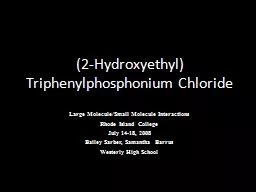

T riphenylphosphonium Chloride Large MoleculeSmall Molecule Interactions Rhode Island College July 1418 2008 Bailey Sarber Samantha Barrus Westerly High School TPPEO Molecular Formula HOCH ID: 604570
Download Presentation The PPT/PDF document "(2-Hydroxyethyl)" is the property of its rightful owner. Permission is granted to download and print the materials on this web site for personal, non-commercial use only, and to display it on your personal computer provided you do not modify the materials and that you retain all copyright notices contained in the materials. By downloading content from our website, you accept the terms of this agreement.
Slide1
(2-Hydroxyethyl) Triphenylphosphonium Chloride
Large Molecule/Small Molecule Interactions
Rhode Island College
July 14-18, 2008
Bailey
Sarber
, Samantha
Barrus
Westerly High SchoolSlide2
TPPEO
Molecular Formula-- HOCH
2
CH2P(C6H5)3ClMolecular Weight—342.79 AMUPhysical State— white, crystalline powderSolubility in Water– not availableLD 50– not availableSlide3
Electrophoresis
Well 2 - kb Ladder
Well 3 - Plasmid DNA sample uncut (5
μL) - 6300 base pairsWell 4 - Plasmid DNA sample uncut (5μL) with 1 µL of TPPEO- 6300 base pairsWell 5 - Plasmid DNA sample linearized (5μL) - 6200
base pairsWell 6 - Plasmid DNA sample linearized (5μ
L) with 1 µL of TPPEO- 6200
base pairs
Possible Conclusions:The doping agent failed to bind with the DNA samples.
The agent bound, but had no effect.
The agent’s concentration was too low.
Final conclusion: Additional tests yielded the same results despite higher concentrations of TPPEO doping agent (3 µL and 5 µL). Slide4
Melting Point of Genomic (Salmon) DNA with Varying Concentrations of TPPEO
Melting points
Control (DNA + Distilled Water) -77.5°C
DNA + 1 μL TPPEO-82.5°CDNA + 3 μL TPPEO-82.5°CDNA + 5 μL TPPEO-82.5°CSlide5Slide6Slide7
Molecular Modeling
Benzene ring - planar surface may provide the best chance of intercalation within DNA
Distance in
Å
Energy in Kcals
1
19.662
95.53
2
18.744
95.52
3
17.765
95.50
4
16.569
95.41
5
15.712
95.15
6
15.159
96.62
7
14.909
95.32
8
6.831
94.2691.3101066.361026.15798.91Optimization26.21692.347
Distance in ÅEnergy in Kcals148.939464.87242.385464.87330.823464.86426.837464.86523.426464.86611.378464.8577.650464.7286.447464.3192.569891.391058.730464.45Optimization60.553178.05
Minor Groove –
Single Point EnergyAtom - C11 of TPPEOAtom - P193 of DNA
Major Groove –Single Point EnergyAtom - C11 of TPPEOAtom - C3*442
Small Molecule/Large Molecule InteractionSlide8
Attempting to Intercalate TPPEO within Adenine-Thymine Base Pairs
Optimizing…
TPPEO fails to intercalate, instead causing the DNA molecule to distort itself away from the drug. Slide9
Attempting to Intercalate TPPEO within Cytosine-Guanine Base Pairs
Optimizing…
TPPEO fails to intercalate, instead causing the DNA to distort and the base pairs to move apart.Slide10
Attempting to Bind TPPEO to the Major Groove of DNA
Optimizing…
TPPEO fails to interact with the major groove, instead causing DNA to distort away from the TPPEO.Slide11
Attempting to Bind TPPEO to the Minor Groove of DNA
Optimizing…
TPPEO appears to interact with the minor groove, causing little DNA distortion.Slide12
Conclusions
Electrophoresis- TPPEO did not affect the migration of the DNA through the gel. The drug either did not bind with DNA or it did bind with the DNA with no affect to the migration through the gel.
Melting Point of Genomic DNA- There was a change in melting temperature between the control sample and those doped with various concentrations TPPEO including 1
μL, 3 μL and 5 μL. The possible shift was 5° Celsius indicating some sort of interaction between the drug and the DNA samples. Further testing is needed to substantiate an actual interaction.
Molecular Modeling- Single point optimization between atoms on TPPEO and DNA revealed that when TPPEO approached the major groove on DNA the optimal energy level was 26.216 Å. This suggests that the interaction based upon these two points is forced. Optimization on the minor groove had a greater overall distance than that of the major groove, at a distance of 60.553Å. The energy level implies the two atoms do not interact well at the minor groove.
Slide13
Adenine-Thymine Intercalation- TPPEO failed to intercalate within base pairs containing adenine-thymine sequences. The double hydrogen bonds connecting the two bases were not strong enough to withstand the distortion caused by the attempted intercalation.
Cytosine-Guanine Intercalation-TPPEO again failed to intercalate between base pairs containing cytosine-guanine. These base pairs moved apart but not as far as the adenine-
thyamine
base pairs because the three hydrogen bonds are stronger then two. Warning: Hyperchem has its limitations. Some sort of interaction appeared to take place in the minor groove of the DNA sequence when both molecules were optimized using the Amber program. This occurred despite the single point optimization not supporting the interaction. Single point optimization only configures two atoms but with so many configurations to test it would be realistically impossible to test them all using a program such as this. Intercalating within a DNA sequence has as many variables; base pair sequences, the size of the DNA molecule, and the location and configurations of the drug yield hypothetical results.Conclusion
: Actual experimentation should be the primary source from which to draw conclusions. Recreating the experiment will quantify/support the data collected and verify the possible binding properties of TPPEO. Hyperchem is a tool, but not to be solely relied on. Slide14
Further Research…
Replicating the experiments
Confirming the assumed minor curve non-covalent bonding nature of TPPEO and DNA using X-Ray Crystallography
Investigate other molecules for possible DNA interaction ex: acetylsalicylic acid , ibuprofen, acetaminophen